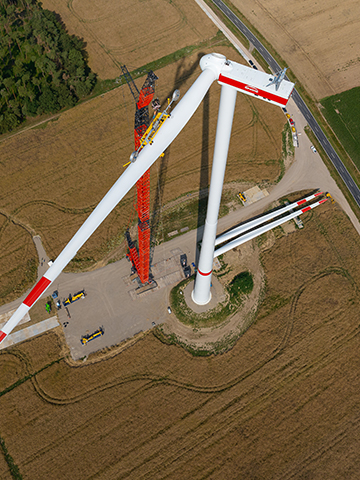Veuillez accepter les cookies "marketing" pour voir cette vidéo.
The Fitou wind farm, located in southern France, underwent an exemplary dismantling: eight turbines installed 22 years ago were replaced with new ones, almost doubling the site’s total capacity.
After twenty years of loyal service, the first generations of wind turbines are reaching the end of their operational lives. Repowering consists of replacing these turbines with new, higher-performing models—on average capable of producing twice as much electricity, sometimes more—while reusing existing infrastructure.
More efficient wind turbines
How? By using more powerful rotors, longer blades that sweep a larger area, improved aerodynamics, better wind capture, and intelligent control systems that optimize real-time operations. Projects also benefit from 20+ years of operational feedback, particularly on biodiversity preservation, acoustic impacts, and landscape integration. The result: turbines that are both more efficient and better integrated into their surroundings, contributing to the energy transition.
ENGIE, which aims to reach 95 gigawatts (GW) of installed renewable and storage capacity by 2030, is active in this promising field. The Group has already launched its first repowering projects in France, Belgium, and Germany, with more planned in Italy.
Wind farms to be renewed
According to consulting firm Wood Mackenzie, 275 GW of onshore wind capacity worldwide will reach 20 years of operation between 2023 and 2033. This aging global fleet is drawing major investment into repowering: total renewed capacity is expected to grow more than sixfold, from 21 GW in 2023 to 134 GW in 2033.
In France, the first wind farms date back to 1991, meaning their replacement process is now well underway.
Repowering offers several advantages. It makes use of existing infrastructure such as access roads, electrical connections, and turbine foundations. It often targets the best, most wind-exposed sites originally selected for their high energy potential. After two decades of operation, these turbines have also become part of the local landscape: familiar, understood, and often well accepted by nearby residents.
“Among the 1,400 wind farms operated by ENGIE Green, we plan to renew four each year over the next ten years, representing a total of around 1 GW. Their generation capacity should double, while the number of turbines will drop by roughly one-third.
For instance, the Haute Lys wind farm in northern France will produce more energy than before, with 17 turbines instead of 25.”
Samuel Renard, CEO of ENGIE Green & SHEM
A European opportunity
Repowering is set to expand across Europe. Germany, with its older wind fleet, is naturally a pioneer. The European Union has urged member states to simplify and accelerate permitting procedures, with a target of no more than six months for project approval.
Repowering thus represents an opportunity to extend the life of existing wind sites, strengthen Europe’s energy sovereignty, and support its carbon-neutrality goals.


